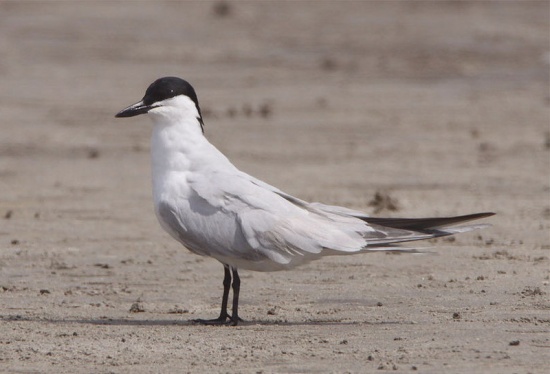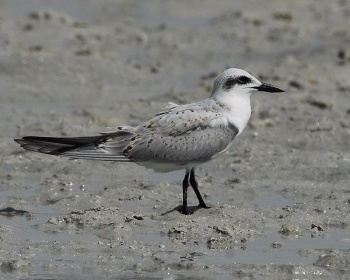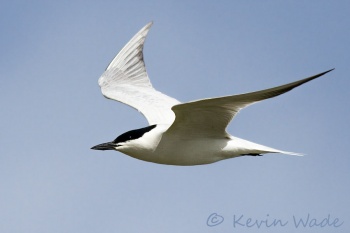Includes: Australian Gull-billed Tern
- Gelochelidon nilotica
Sterna nilotica
Identification
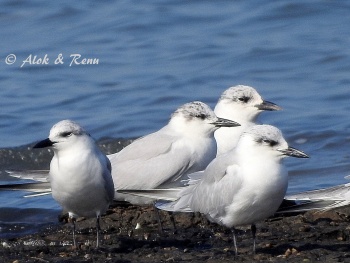
Photo © by Alok Tewari
Jamnagar, Coastal Gujarat, India, Jan-2016
Length 33–43 cm (13-17 in), wingspan 85-103 cm, weight 130-300 g.
A stocky but long-legged, gull-like tern with a stout, all-black bill. In flight, broad-winged, reminiscent of a small gull or a large marsh tern.
- cap black in summer, reduced to a small black ear patch in winter
- tail only shallowly forked
- upperparts, including wings, pale silvery-grey
- tips of primaries dark, generally giving a dark trailing edge
- rump and tail either pale silvery grey or white (macrotarsa)
- underparts white
- legs black, long
Juvenile with buffy-brown to blackish 'V'-marks above, otherwise similar to winter adult.
Similar Species
- Sandwich Tern has a yellow tip to the black bill, shorter legs, relatively longer, narrower wings in flight, shaggy crest, and white rump and tail; in winter plumage, retains black at rear of head, less so over ear coverts.
- Whiskered Tern has similar structure, and plumage pattern in winter, but is substantially smaller - though can be hard to tell where size not easily judged - and with slightly more extensive black on rear of head.
- In winter plumage, Forster's Tern has similar, though more obvious, black ear patches.
Distribution
Like the Caspian Tern, widespread but patchy distributed, breeding in temperate and subtropical regions globally, though not extending so far north as Caspian Tern, in Europe only to 54°N (in northern Germany, though formerly also bred in western Denmark at 56°N), and in North America to 41°N (on Long Island, New York).
Also local in Asia, South America, Australia and New Zealand. Migratory in the temperate Northern Hemisphere, wintering south to the tropics; resident or dispersive in the subtropics and the temperate Southern Hemisphere.
An annual vagrant in the British Isles, mostly to the south coast.
Taxonomy
Australian subspecies macrotarsa may be split as "Australian Gull-billed Tern", G. macrotarsa (e.g. IOC: see [5]).
This species was in the past included in the genus Sterna. Its genetic closest relative is Caspian Tern.
Subspecies
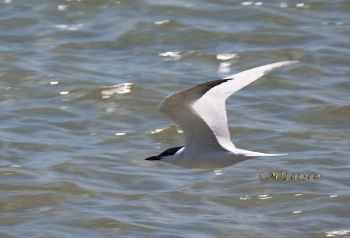
Photo © by NJLarsen
Pitt Street Causeway, Charleston, South Carolina, 1 May 2023
Morphological differences between races are slight, involving overall size and bill size.
Clements recognises the following subspecies [1]:
- G. n. nilotica: Europe, western and southern Asia; winters tropical Africa and Persian Gulf to India
- G. n. addenda: Eastern Asia from Transbaikalia to Manchuria and eastern China; winters South-eastern Asia
- G. n. macrotarsa: "Australian Gull-billed Tern". Australia (except arid areas). [The largest subspecies. Non-breeding: larger black ear coverts which are square-ended. Back and wings very pale with white rather than grey rump and upper tail.]
- G. n. aranea: Eastern USA to Greater Antilles and Yucatán; winters to Brazil and Peru
- G. n. vanrossemi: California to northern Baja and north-western Mexico; winters to Ecuador
- G. n. gronvoldi: Coasts and rivers of French Guiana to north-eastern Argentina
Race addenda is called affinis by the IOC.
Habitat
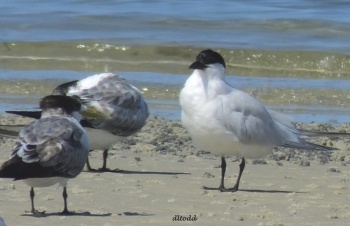
Photo © by Delia Todd
Bribie Island, Queensland, Australia, 4 October 2019
Breeds on sandy shores of the sea and large lakes, but - uniquely for a tern - feeds mainly over land, typically over coastal marshes and fields. Also overwinters near inland waters (lagoons, marshes, lakes, rivers etc).
Behaviour
Diet
The diet consists mostly of large insects, but also feeds on frogs and small mammals.
Breeding
Breeds colonially in a variety of habitats: lakes, fresh and saline marshes. Also mountain lakes to a height of around 2000m.
References
- Clements, J. F., T. S. Schulenberg, M. J. Iliff, S. M. Billerman, T. A. Fredericks, B. L. Sullivan, and C. L. Wood. 2019. The eBird/Clements Checklist of Birds of the World: v2019. Downloaded from http://www.birds.cornell.edu/clementschecklist/download/
- Collins Pocket Guide to British Birds 1966
- Collins Field Guide 5th Edition
- Collins Bird Guide ISBN 0 00 219728 6
- Gill, F, D Donsker, and P Rasmussen (Eds). 2023. IOC World Bird List (v 13.2). Doi 10.14344/IOC.ML.13.2. http://www.worldbirdnames.org/
Recommended Citation
- BirdForum Opus contributors. (2024) Gull-billed Tern. In: BirdForum, the forum for wild birds and birding. Retrieved 8 November 2024 from https://www.birdforum.net/opus/Gull-billed_Tern
External Links
GSearch checked for 2020 platform.1




